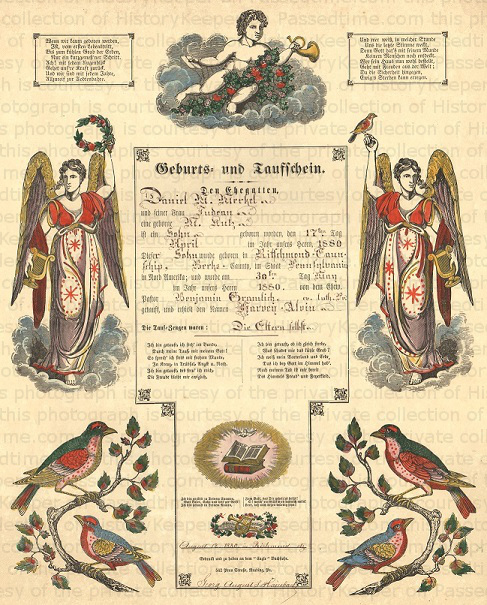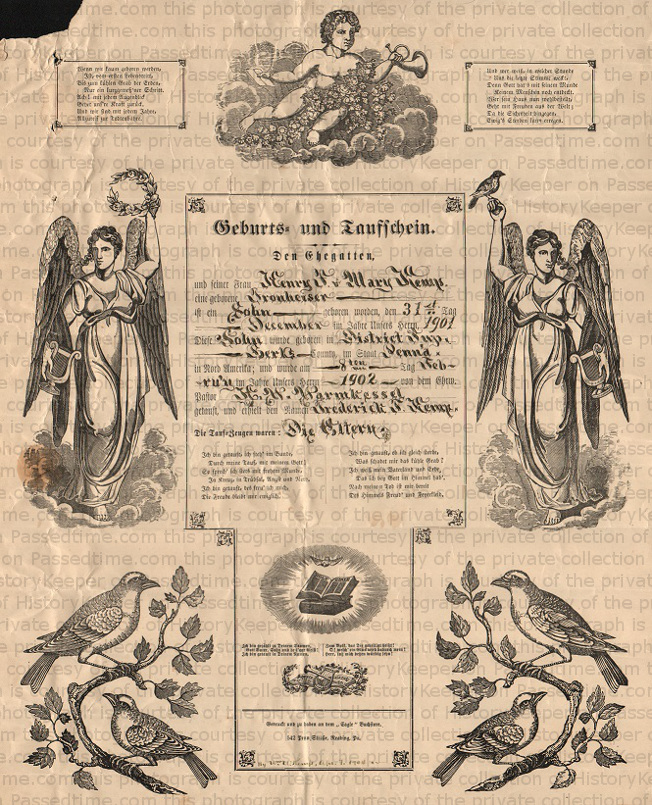Recently 94.7 WMAS out of Springfield, Massachusettes, began a conversation on Facebook. Massachusetts school personnel want to keep penmanship in the curriculum. The people at 94.7 WMAS pose the following question, should penmanship be kept alive? In this day of the computer, speed, mass-produced, impersonal, and homogenous dreck, I know many would question the point of penmanship, especially given the infallibility of computers and the electrical grid. Penmanship, however, is not only a means of communication, but it is an art form. Throughout the years, many have made a living with this craft.
Consider this Pennsylvania German (sometimes called the Pennsylvania Dutch) birth and baptism certificate or taufschein (figure 1). 1 The text was written and recorded in German by scrivener Georg August S. Hainbach (active c. 1876-1919).  Although, this birth and baptism certificate is printed, families commissioned men such as Hainbach to infill the information pertinent to the family. In her flagship work, Papers For Birth Dayes / Guide To The Fraktur Artists and Scriveners, Corinne Earnest 2 states that Hainbach was one of the most prolific and sought after scriveners. He was often hired to fill out Bible records in both the German and English language, undoubtedly because "his Bible records are unsurpassed in beauty, both for the penmanship and the little drawings he made in Bibles." 3 He, obviously, also filled out taufscheine. This particular example, is one of Hainbach's restrained efforts, but the delicate penmanship is nonetheless valued by collectors and enthusiasts. Another example of his skill is shown at the end of the article (figure 4). These two examples demonstrate the breadth of his skill.
Although, this birth and baptism certificate is printed, families commissioned men such as Hainbach to infill the information pertinent to the family. In her flagship work, Papers For Birth Dayes / Guide To The Fraktur Artists and Scriveners, Corinne Earnest 2 states that Hainbach was one of the most prolific and sought after scriveners. He was often hired to fill out Bible records in both the German and English language, undoubtedly because "his Bible records are unsurpassed in beauty, both for the penmanship and the little drawings he made in Bibles." 3 He, obviously, also filled out taufscheine. This particular example, is one of Hainbach's restrained efforts, but the delicate penmanship is nonetheless valued by collectors and enthusiasts. Another example of his skill is shown at the end of the article (figure 4). These two examples demonstrate the breadth of his skill.
Not all families chose to hire a professional. Sometimes a family member possessed skills to infill a taufschein. (figure 2). In this case, William W. Kemp is not known as a scrivener, but obviously he had the skill to complete the taufschein. Often schoolmasters offered their services to supplement their income and it is possible Kemp was among that group.
.
 Fig. 2. Taufschein infilled by William Kemp. Private Collection
Fig. 2. Taufschein infilled by William Kemp. Private Collection
Often the artist who embellished a sheet is completely anonymous. Joseph Laubach may have written the bilingual page (figure 3), or someone might have done it for him. The sheet was torn from a notebook or book, long separated from this surviving artifact. Other papers found with this page indicate Laubach was a tailor, or at least served the fashion industry in some capacity in Philadelphia in the mid-nineteenth century. If Laubach is the artist, he did not make his living as a scrivener as far as is known. He might have done it for pleasure or out of appreciation for the art. Much like Hainbach's effort below, (figure 4), sometimes the love of the craft shines through. Pat Earnest 12 June 2015 Passed Time.


Fig. 4. Taufschein illuminated by Hainbach. Image courtesy of Earnest Archives and Library
Footnotes:
1. For more information about the Pennsylvania Germans and their Fraktur art, I highly recommend checking out the Earnest Archives and Library. Russ and Corinne Earnest now have recorded the information from over 40,000 (yes, that is right) 40,000 Pennsylvania German birth and baptism certificates. They have also written over seventeen books about the Pennsylvania German broadside, fraktur, and genealogy. Corinne also writes the ever popular Fraktur and Families series, which provides access to some of the 40,000 genealogical entries they have recorded.
2. Corinne Earnest is the foremost fraktur expert. In addition to the books she has written, she has contributed countless articles to many genealogical and historical societies through the years.
3. Earnest, Russell and Corinne. Papers For Birth Dayes: Guide To The Fraktur Artists And Scriveners. Volume I. Second Edition. Published by Russell D. Earnest Associates, 1997. pp 349-350.
Author Pat Earnest, currently lives in Dover, Delaware, with family, both two- and four-footed. I am a published author and history enthusiast, who has great regard for the past and is especially proud of the Pennsylvania German culture. In addition to Passed Time, I am currently working on a project for the German Historical Institutes Immigrant Entrepreneurship: German-American Business Biographies (http://www.ghi-dc.org). I also contribute to various newsletters and I am working on another book...or two. Feel free to email me at pcsuter@passedtime.com for questions, comments, information, a shared love of history, an idea, or just because you want to share on Passed Time, but are too shy about getting started. But be aware, Files with Attachments will not be opened, but immediately deleted.
Comments (7)
-
Guest - alil
PermalinkThis is a very informative article. I am also agree with your post title and your really well explain your point of view. I am very happy to see this post. Thanks for share with us. Keep it up and share the more most related post.
buy youtube views UK
buy youtube views USA
buy youtube views cheap0 Like -
Guest - jarry
PermalinkI am reading your whole blog. This is very amazing and interesting blog. I really like it. I will bookmark your blog on the other pages. Thanks for sharing this blog.
jazz net packages
jazz internet packages
zong 3g packages
zong 4g packages0 Like -
Guest - ROZI
PermalinkYou should mainly superior together with well-performing material, which means that see it: Serious Questions
0 Like -
Guest - leilei3915
Permalink2018203 leilei3915
coach factory outlet
ugg boots
pandora charms
ralph lauren
michael kors outlet store
canada goose parka sale
canada goose jackets
polo ralph lauren outlet
nike shoes
michael kors outlet
fitflops sale clearance
canada goose
nfl jerseys
coach factory outlet
canada goose outlet stores
fitflops sale clearance
michael kors outlet clearance
air max 90
nike shoes
true religion jeans
coach outlet store online
giuseppe zanotti shoes
michael kors outlet
pandora outlet
ray ban sunglasse
coach outlet
ugg outlet
fred perry
cheap jordans
ray ban
coach outlet store online
mlb jerseys wholesale
canada goose jackets
giuseppe zanotti outlet
pandora charms
nike outlet store
adidas yeezy
kate spade outlet
polo ralph lauren outlet online
nike trainers
polo ralph lauren outlet
pandora jewelry
longchamp handbags
oakley sunglasses
jordan shoes
cheap jordans for sale
canada goose outlet store
yeezy boost 350 v2
uggs outlet
mont blanc pens
canada goose jackets
nfl jerseys
canada goose jackets
adidas nmd
ralph lauren
uggs outlet
ralph lauren sale clearance
coach outlet store online
nike shoes outlet
michael kors outlet
coach outlet clearance
canada goose jackets
michael kors outlet
nfl jerseys
mont blanc outlet
uggs outlet
clarks outlet
ugg outlet
coach outlet store online
coach outlet store online
pandora outlet
moncler jackets
coach outlet
coach outlet online
coach outlet
clarks shoes
oakley sunglasses wholesale
coach outlet
yeezy boost 350
coach factory outlet online
adidas outlet
michael kors outlet clearance
hermes outlet
michael kors outlet online
ray ban outlet
uggs outlet
ugg boots
canada goose outlet
oakley sunglasses for men
coach outlet
michael kors outlet clearance
christian louboutin shoes
michael kors handbags
pandora charms
polo ralph lauren outlet
coach factory outlet
ugg outlet
nike outlet online
uggs outlet
uggs outlet0 Like -
Thank you for the auspicious write up. Really great work done. Please also visit the link : ERP Software
0 Like -
Guest - seo
PermalinkI have never worked with a company like this. I bought a custom door from them for a major renovation and their response was very quick. Check out their https://caldwells.com/interior-doors/shaker-doors here.
0 Like

Leave your comments
Login to post a comment
Post comment as a guest